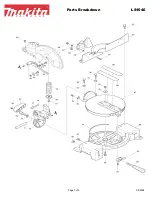
19
BASIC SAW OPERATIONS
“ON/OFF” SWITCH (FIG. P)
The switch with safety key is intended to
prevent unauthorized use of the band saw.
1. To turn the band saw ON, insert the
yellow safety key (1) into the key slot in
the center of the switch (2).
2. Push the key firmly into the slot, then
push switch (2) to the ON position to start
the band saw.
3. To turn the band saw OFF, push the
switch (2) to the OFF position.
4. Remove the yellow safety key (1) by
pulling it outward when the saw is
complete stop.
Remove the black safety key (1) whenever
the saw is not in use. Place it in a safe place
and out of reach of children.
Fig. P
GENERAL CUTTING
For your safety, read and understand all
SAFETY INSTRUCTIONS on pages 4-8
before using the band saw.
Operating band saws involves a certain
amount of hazard. Before attempting regular
work, use scrap lumber to check the settings,
and to get the feel of operating the band saw.
Read instructions and plan your work before
cutting a workpiece.
Do not turn the power ON until after you have
made all adjustments, checked that the guard
is in place, and turned the wheel by hand to
make sure all parts work properly. Always
keep the guide assembly 1/8 in. (3.2 mm)
above the workpiece.
WARNING
!
WARNING
!
OPERATION
1
2
Do not force the workpiece against the blade.
Light contact permits easier cutting and prevents
unwanted friction and heating of the blade.
Sharp saw blades need little pressure for
cutting. Steadily move the workpiece against
the blade without forcing it.
To avoid twisting the blade do not turn sharp
corners; saw around corners.
A band saw is basically a “curve-cutting”
saw. It is not capable of doing intricate inside
cutting as can be done with a scroll saw.
It is also used for straight line operations such
as crosscutting, ripping, mitering, beveling,
compound cutting, and resawing.
To avoid blade breakage, fire or other
damage or injury, NEVER use this band saw
to cut metals.
CUTTING CURVES
When cutting curves, carefully turn the
workpiece so the blade may follow without
twisting. If the curve is so sharp that you
repeatedly back up and cut new kerf, use a
narrower blade, or a blade with more set (teeth
further apart). When a blade has more set, the
workpiece turns easier but the cut is rougher.
When changing a cut, do not withdraw the
workpiece from the blade. The blade may get
drawn off the wheels. To change a cut, turn
the workpiece and saw out through the scrap
material area.
When cutting long curves, make relief cuts as
you go along.
ClRCLE CUTTING (FIG. Q)
1. Adjust the guide assembly to 1/8 in.
(3.2 mm) above the workpiece.
2. Use both hands while feeding the work
into the blade. Hold the workpiece firmly
against the table. Do not force the work
and operate with gentle pressure.
3. The smallest diameter circle that can
be cut is determined by the width of the
blade. For example, a 1/4 in. (6.4 mm)
wide blade will cut a minimum diameter of
approximately 1-1/2 in. (38.1 mm).
WARNING
!
Содержание PCXB310BS
Страница 10: ...10 UNPACKING YOUR BAND SAW A B C D E...
Страница 27: ...27 NOTES...










































